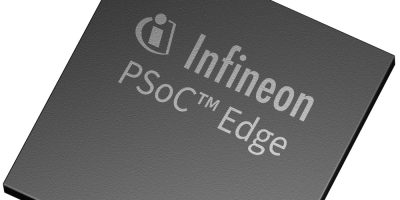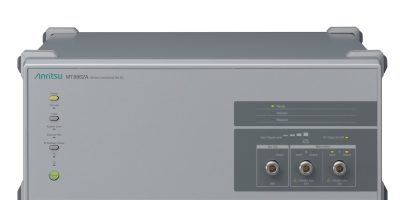A new family of microcontrollers have been added to Infineon Technologies’ PSoC portfolio of Arm Cortex-based, high performance, low power, secured devices.
PSoC Edge is designed for next generation, responsive compute and control applications, featuring hardware-assisted machine learning (ML) acceleration. The microcontrollers enable end products to be more intelligent and intuitively usable, by lowering the barrier in human-machine interaction and adding contextual awareness to end applications, explained Infineon. At the same time, they provide robust privacy and safety protection through embedded Infineon Edge Protect technologies.
Microcontrollers in the new PSoC Edge portfolio offer a mix of scalable power and performance to support emerging AI/ML requirements, extensive HMI capabilities and security features required for next-generation applications. All supported with a deep ecosystem of software and tools, fit for task, said Steve Tateosian, senior vice president of microcontrollers for Infineon.
The PSoC Edge devices are based on Arm Cortex-M55, including Helium DSP support paired with Arm Ethos-U55 and Cortex-M33 paired with Infineon’s low power NNLite which is a proprietary hardware accelerator intended to accelerate the neural networks used in ML and AI applications. There is also support for always-on sensing and response which makes them suitable for advanced IoT and industrial segments such as smart home, security, wearables and robotics, said the company. The family of devices comes with non-volatile, on-chip RRAM as well as high speed, secured external memory support. The PSoC Edge family provides scalability for next-generation intelligent systems while enabling software reuse and portability, Infineon added.
The enhanced intelligence of the PSoC Edge family extends support for advanced graphics, voice, audio and vision-based applications to the existing PSoC portfolio. The new family enables easy migration of applications within the family, as well as an upgrade path from existing designs.
Developers can leverage the power of PSoC Edge for current and future design needs. There is also a strong ecosystem partners, comprehensive documentation and the ModusToolbox software, including integration with Imagimob Studio AI to accelerate time to market.
Infineon’s ModusToolbox software platform provides a collection of development tools, libraries, and embedded runtime assets for a flexible and comprehensive development experience for consumer IoT, industrial, smart home and wearable applications.
Imagimob Studio is an Edge AI development platform, integrated into ModusToolbox, and delivers end to end ML development, from data in to model deployed. There are starter projects and Imagimob’s Ready Models available all designed to support developer deploying ML models for the edge.
The PSoC Edge family is available for early access customers now.
IoT
High-speed gate driver IC save energy in miniature lidar applications
Energy saving and miniaturisation in lidar applications and data centres are possible with the BD2311NVX-LB gate driver IC, claimed Rohm Semiconductor. It is optimised for GaN devices and achieves gate drive speeds on the order of nanoseconds which is suitable for high speed GaN switching. This results in fast switching with a minimum gate input pulse width of 1.25 nanoseconds that contributes to smaller, more energy efficient, higher performance applications, said Rohm.
Improving power conversion efficiency while reducing the size of power supply units in server systems are priorities as the number of IoT devices continues to grow. At the same time, lidar which is used for monitoring industrial equipment and social infrastructure as well as vehicles, demands high-speed pulsed laser light to further increase recognition accuracy.
GaN devices are sensitive towards gate input overvoltage, Rohm has developed a method to suppress the gate voltage overshoots and has implemented it into this driver. The optimum GaN device can be selected by adjusting the gate resistance based on application requirements, explained Rohm. The BD2311NVX-LB gate driver has a gate overvoltage suppression feature and when used with Rohm’s EcoGaN products simplifies a design and enhances application reliability.
Professor Yue-Ming Hsin, from the Department of Electrical Engineering, National Central University, Taiwan, said: “GaN devices are expected to be materials that can demonstrate performance in the high-frequency range more than silicon. In power switching applications such as DC/DC and AC/DC converters, and in lidar applications, the performance of GaN devices can contribute to smaller, more energy-efficient, and higher performance applications,” he said.
A team from the National Taipei University of Technology and Chang Gung University are working together on the same project, testing Rohm BD2311NVX gate driver IC.
The results showed that BD2311NVX had shorter rise time and lower ringing at 1MHz switching frequency for boost converters compared to other driver ICs.
The reduced rise time of this driver IC will help maximise the reduction in switching losses, which is an advantage of GaN.
Target applications are lidar drive circuits in industrial equipment or infrastructure monitoring, DC/DC converter circuits in data centres and base stations, wireless charging for portable devices and Class D audio amplifiers.
The IC is available from online distributors, Farnell, DigiKey and Mouser.
The IC will be offered at other online distributors as it becomes available.
Reference designs for lidar, 150V EcoGaN and high power laser diodes are now available on Rohm’s website.
NXP adds Wi-Fi 6E to automotive wireless connectivity
Advanced automotive security together with concurrent dual Wi-Fi 6E and Bluetooth 5.3 are enabled in NXP’s automotive wireless connectivity portfolio with the introduction of the AW693 wireless connectivity device.
The integrated AW693 enables multiple secure connections within the car, supporting the transition to software-defined vehicles, said NXP. It enables concurrent dual Wi-Fi 6E and Bluetooth 5.3 connections and is protected by NXP’s integrated Edgelock secure subsystem.
Targeting telematics and in-vehicle infotainment, the AW693 supports connectivity across multiple automotive platforms when combined with NXP’s i.MX 8 and 9 series of applications processors. This enables secure delivery of the over the air software updates and also facilitates secure connections between various systems and mobile devices inside the car.
In addition to updates to ensure vehicle platforms are equipped with the latest features and security, new and future vehicles will require constant connection between vehicle systems, said NXP. This will include the secure upload and download of sensor information, camera feeds, diagnostics data and other features, as well as communication between the vehicle and mobile devices.
This requires low latency and simultaneous multi-band connectivity to support both legacy and new devices. It also needs connection stability to allow seamless communication throughout a vehicle. According to NXP, its AW693 can be used with its Concurrent Dual Wi-Fi to incorporate an access point-like design approach.
The AW693 offers concurrent dual Wi-Fi 6E and Bluetooth 5.3 operation, with integrated 2.4GHz and 5.0 to 7.0GHz TX power amplifiers, RX low noise amplifiers, Tx/Rx switches and a full Bluetooth radio. NXP’s integrated EdgeLock secure subsystem supports hardware crypto-accelerated secure boot, key management, firmware authentication, secure life cycle management and anti-rollback protection. The AW693 is AEC-Q100 Grade 2-compliant.
NXP’s i.MX 95 family quickly and easily integrates the AW693 to enable safety-capable, secure automotive platforms and offers efficient machine learning acceleration, said the company2, adding that this helps to simplify development and reduce costs.
The AW693 is part of a portfolio of automotive wireless connectivity solutions that includes the AW692, the AW690, the AW611 and the Q9098.
WLAN tester supports Wi-Fi 7 comms evaluation
Devices based on the Wi-Fi 7 communications standard are already being developed, creating a growing demand for test instrumentation that can evaluate them.
To meet this need, Anritsu has introduced a Network Mode option for its MT8862A wireless connectivity test set. This mode emulates real world operation to evaluate RF characteristics. It uses the data link layer communication protocol implemented in both the chip and the tester to establish communication. In addition to evaluating RF characteristics using conducted tests, the network mode is useful for over the air (OTA) wireless performance testing, including antenna characteristics, of finished products.
Developed by the Institute of Electrical and Electronics Engineers, the IEEE802.11be (Wi-Fi 7) wireless communication standard is the successor to the IEEE802.11ax (Wi-Fi 6/6E) WLAN standard, supporting theoretical maximum speeds up to 9.61Gbps.
The new standard is designed to achieve a transmission speed of 30Gbps or more, which is much faster than Wi-Fi 6/6E. In addition to extending conventional technologies, including 4096 QAM, 320 MHz channel bandwidth, and Multi-RU, Wi-Fi 7 also adopts new technologies such as multi-link operation (MLO), enabling a device to simultaneously send and receive data across different frequency bands and channels.
The development of the Wi-Fi 7 standard is scheduled for completion in 2024 and is expected to be used for devices that support the latest applications and services, such as ultra-high-definition video streaming and AR/VR. Devices using chips based on the draft standard of Wi-Fi 7 have already appeared and there is rapidly increasing demand for test instruments to evaluate these devices.
The MT8862A allows the user to specify the data rate for the test, enabling RF evaluation to be conducted at all the data rates used by the major WLAN standards, including Wi-Fi 7.
It also provides a test environment for evaluating RF TRX characteristics (e.g., TX power, modulation accuracy, RX sensitivity) of WLAN devices, including Wi-Fi 7.
About Smart Cities
This news story is brought to you by smartcitieselectronics.com, the specialist site dedicated to delivering information about what’s new in the Smart City Electronics industry, with daily news updates, new products and industry news. To stay up-to-date, register to receive our weekly newsletters and keep yourself informed on the latest technology news and new products from around the globe. Simply click this link to register here: Smart Cities Registration







